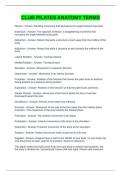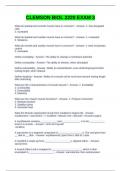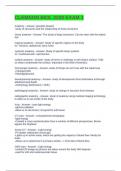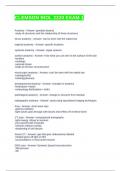Freshy
On this page, you find all documents, package deals, and flashcards offered by seller Freshy.
- 2482
- 0
- 49
Community
- Followers
- Following
2530 items

CLUB PILATES ANATOMY TERMS EXAM QUESTIONS AND ANSWERS
CLUB PILATES ANATOMY TERMS Flexion - Answer- Bending movement that decreases the angle between two parts Extension - Answer- The opposite of flexion; a straightening movement that increases the angle between body parts Abduction - Answer- Motion that pulls a structure or part away from the midline of the body Adduction - Answer- Motion that pulls a structure or part towards the midline of the body Lateral Rotation - Answer- Turning outward Medial Rotation - Answer- Turning inwa...
- Exam (elaborations)
- • 2 pages •
CLUB PILATES ANATOMY TERMS Flexion - Answer- Bending movement that decreases the angle between two parts Extension - Answer- The opposite of flexion; a straightening movement that increases the angle between body parts Abduction - Answer- Motion that pulls a structure or part away from the midline of the body Adduction - Answer- Motion that pulls a structure or part towards the midline of the body Lateral Rotation - Answer- Turning outward Medial Rotation - Answer- Turning inwa...

PILATES ANATOMY EXAM QUESTIONS WITH CORRECT ANSWERS
PILATES ANATOMY Psoas Major - Answer- Biggest muscle Connects upper and lower body Down the side Sidebending, flexion, and rotation Transverse Abdominis - Answer- Deepest abdominal Diaper around the body For stability Internal Oblique - Answer- Points towards "I" Lateral Side bending, flexion of the spine External Oblique - Answer- Muscle fibers run away from "I" Side-bending and rotation Rectus Abdominus - Answer- Least deep 6-pack For flexion of the spine ...
- Exam (elaborations)
- • 2 pages •
PILATES ANATOMY Psoas Major - Answer- Biggest muscle Connects upper and lower body Down the side Sidebending, flexion, and rotation Transverse Abdominis - Answer- Deepest abdominal Diaper around the body For stability Internal Oblique - Answer- Points towards "I" Lateral Side bending, flexion of the spine External Oblique - Answer- Muscle fibers run away from "I" Side-bending and rotation Rectus Abdominus - Answer- Least deep 6-pack For flexion of the spine ...

ANATOMY PILATES EXAMS QUESTIONS AND ANSWERS
ANATOMY PILATES The breastbone is called - Answer- sternum Another name for the first cervical vertebra (C1) is the _________. - Answer- Atlas Another name for the second cervical vertebra (C2) is the ______. - Answer- Axis Bottom of the sternum - Answer- xiphoid process Top of the sternum - Answer- manubrium This bone connects the manubrium of the sternum to the acromion process of the scapula. (It is also called the collar bone) - Answer- Clavicle shoulder and hip - Answer...
- Exam (elaborations)
- • 3 pages •
ANATOMY PILATES The breastbone is called - Answer- sternum Another name for the first cervical vertebra (C1) is the _________. - Answer- Atlas Another name for the second cervical vertebra (C2) is the ______. - Answer- Axis Bottom of the sternum - Answer- xiphoid process Top of the sternum - Answer- manubrium This bone connects the manubrium of the sternum to the acromion process of the scapula. (It is also called the collar bone) - Answer- Clavicle shoulder and hip - Answer...

PILATES ANATOMY/CERTIFICATION EXAM QUESTIONS AND ANSWERS
PILATES ANATOMY/CERTIFICATION What two bones make up the glenohumeral joint? - Answer- scapula and humerus (shoulder joint) Name the four rotator cuff muscles - Answer- SITS Supraspinatus Infraspinatus Teres Minor Subscapularis The labrum provides stability to which of the following? - Answer- Shoulder joint What is the name of the ligament at the Acromioclavicular joint? - Answer- Coracoclavicular ligaments Atrophy - Answer- loss of tone and strength Briefly explain imping...
- Exam (elaborations)
- • 5 pages •
PILATES ANATOMY/CERTIFICATION What two bones make up the glenohumeral joint? - Answer- scapula and humerus (shoulder joint) Name the four rotator cuff muscles - Answer- SITS Supraspinatus Infraspinatus Teres Minor Subscapularis The labrum provides stability to which of the following? - Answer- Shoulder joint What is the name of the ligament at the Acromioclavicular joint? - Answer- Coracoclavicular ligaments Atrophy - Answer- loss of tone and strength Briefly explain imping...

CLEMSON BIOL 2220 EXAM 4 QUESTIONS AND ANSWERS
CLEMSON BIOL 2220 EXAM 4 what does the CNS consist of? What does it do? - Answer- brain spinal cord -nervous control center -interprets sensory -dictates motor output based on reflexes, current/past experiences What does the PNS consist of? What does it do? - Answer- part of nervous system outside the CNS -mainly nerves & ganglia -serves as a communication line for CNS What are 2 portions of the PNS? - Answer- Sensory (Afferent) division Motor (Efferent) division What d...
- Exam (elaborations)
- • 2 pages •
CLEMSON BIOL 2220 EXAM 4 what does the CNS consist of? What does it do? - Answer- brain spinal cord -nervous control center -interprets sensory -dictates motor output based on reflexes, current/past experiences What does the PNS consist of? What does it do? - Answer- part of nervous system outside the CNS -mainly nerves & ganglia -serves as a communication line for CNS What are 2 portions of the PNS? - Answer- Sensory (Afferent) division Motor (Efferent) division What d...

CLEMSON BIOL 2220 ANATOMY AND PHYSIOLOGY 1 EXAM QUESTIONS AND ANSWERS
CLEMSON BIOL 2220 ANATOMY AND PHYSIOLOGY 1 light - Answer- what energy does an xray use xray - Answer- imaging device that looks at hard tissue/dense structures CT - Answer- imaging device that creates a cross sectional plane from a number of different perspectives. Looks at bone light - Answer- what energy does a CT use xeon CT - Answer- imaging device that looks at active tissue xeon CT - Answer- imaging device that requires the patient to inhale a radioactive gas xeon CT ...
- Exam (elaborations)
- • 16 pages •
CLEMSON BIOL 2220 ANATOMY AND PHYSIOLOGY 1 light - Answer- what energy does an xray use xray - Answer- imaging device that looks at hard tissue/dense structures CT - Answer- imaging device that creates a cross sectional plane from a number of different perspectives. Looks at bone light - Answer- what energy does a CT use xeon CT - Answer- imaging device that looks at active tissue xeon CT - Answer- imaging device that requires the patient to inhale a radioactive gas xeon CT ...

CLEMSON BIOL 2220 EXAM 3 QUESTIONS AND ANSWERS
CLEMSON BIOL 2220 EXAM 3 What do skeletal and smooth muscle have in common? - Answer- 1. has elongated cells 2. nucleated What do skeletal and cardiac muscle have in common? - Answer- 1. nucleated 2. Striations What do smooth and cardiac muscle have in common? - Answer- 1. both involuntary control 2. nucleated Define excitability - Answer- The ability to change a membrane potential Define contractility - Answer- The ability to shorten, when stimulated Define extensibility -...
- Exam (elaborations)
- • 8 pages •
CLEMSON BIOL 2220 EXAM 3 What do skeletal and smooth muscle have in common? - Answer- 1. has elongated cells 2. nucleated What do skeletal and cardiac muscle have in common? - Answer- 1. nucleated 2. Striations What do smooth and cardiac muscle have in common? - Answer- 1. both involuntary control 2. nucleated Define excitability - Answer- The ability to change a membrane potential Define contractility - Answer- The ability to shorten, when stimulated Define extensibility -...

CLEMSON BIOL 2220 1 QUESTIONS WITH CORRECT ANSWERS
CLEMSON BIOL 2220 EXAM 1 Anatomy - Answer- greek(to dissect) -study of structures and the relationship of those structures Gross anatomy - Answer- The study of large structures. Can be seen with the naked eye regional anatomy - Answer- Study of specific regions in the body ex. Thoracic, abdominal, neck, knee systemic anatomy - Answer- Study of specific body systems ex. Cardiovascular, reproductive surface anatomy - Answer- study of forms or markings on the body's surface. T...
- Exam (elaborations)
- • 13 pages •
CLEMSON BIOL 2220 EXAM 1 Anatomy - Answer- greek(to dissect) -study of structures and the relationship of those structures Gross anatomy - Answer- The study of large structures. Can be seen with the naked eye regional anatomy - Answer- Study of specific regions in the body ex. Thoracic, abdominal, neck, knee systemic anatomy - Answer- Study of specific body systems ex. Cardiovascular, reproductive surface anatomy - Answer- study of forms or markings on the body's surface. T...

CLEMSON BIOL 2220 EXAM 1 QUESTIONS AND ANSWERS
CLEMSON BIOL 2220 EXAM 1 Anatomy - Answer- greek(to dissect) -study of structures and the relationship of those structures Gross anatomy - Answer- can be seen with the naked eye regional anatomy - Answer- specific locations systemic anatomy - Answer- organ systems surface anatomy - Answer- from what you can see on the surface of the skin -tendons -markings -vascular tissue -leads to forensic reconstruction microscopic anatomy - Answer- can't be seen with the naked eye...
- Exam (elaborations)
- • 13 pages •
CLEMSON BIOL 2220 EXAM 1 Anatomy - Answer- greek(to dissect) -study of structures and the relationship of those structures Gross anatomy - Answer- can be seen with the naked eye regional anatomy - Answer- specific locations systemic anatomy - Answer- organ systems surface anatomy - Answer- from what you can see on the surface of the skin -tendons -markings -vascular tissue -leads to forensic reconstruction microscopic anatomy - Answer- can't be seen with the naked eye...

BIOS 255 FINAL EXAM QUESTIONS AND ANSWERS
BIOS 255 FINAL Functions of blood - Answer- transportation, regulation, protection components of blood - Answer- plasma, red blood cells, white blood cells, platelets Figure 19.3 Origin, developement, and structure of blood cells - Answer- blood clotting - Answer- thickened gel, this gel is serum which is blood plasma minus the clotting proteins. It has insoluble protein fibers aka FIBRIN, which the formed elements of blood are trapped. Hemeostasis - Answer- sequence of responses...
- Exam (elaborations)
- • 16 pages •
BIOS 255 FINAL Functions of blood - Answer- transportation, regulation, protection components of blood - Answer- plasma, red blood cells, white blood cells, platelets Figure 19.3 Origin, developement, and structure of blood cells - Answer- blood clotting - Answer- thickened gel, this gel is serum which is blood plasma minus the clotting proteins. It has insoluble protein fibers aka FIBRIN, which the formed elements of blood are trapped. Hemeostasis - Answer- sequence of responses...
